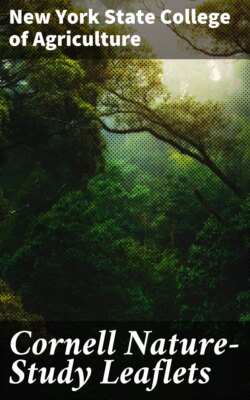Читать книгу Cornell Nature-Study Leaflets - New York State College of Agriculture - Страница 17
Second Grade.
ОглавлениеThe plan for the second year is to continue the study of the life-histories of insects. The pupil, having learned the different stages of the moths and butterflies, should learn that all insects do not experience such marvelous changes of form.
Fall work.—Arrange a breeding cage like figs. 288, 289, Insect Life, p. 329, placing fresh sod in the flower pot and covering the lamp chimney with a square of wire netting. Push the glass chimney down into the earth so as to allow no crevices through which the insects may escape. In such a cage, place grasshoppers and crickets of all sizes, and study their growth. Insect Life, pp. 33-37.
Show the pupils that the young grasshopper looks like the old one except that the wings are shorter; the same is true of crickets. Keep the sod damp so the grass will not become dry; and when it gets too old replace it with other sod. A good way to keep these insects alive and to keep the children interested in them is to plant wheat and grass seed in several flower pots, and then to move the glass chimney from pot to pot, giving the insects fresh pasturage when needed.
As early as possible start some aquaria. Cornell Teachers' Leaflet, No. 11 (No. XII, this volume); Insect Life, pp. 330-332.
The mosquito is one of the most available insects for study in the aquarium. Insect Life, pp. 131-136; Lessons in Nature-Study, p. 12.
The nymphs of dragon flies and damsel flies and many others may be studied during the entire winter. Insect Life, pp. 140-142; Cornell Teachers' Leaflet, No. 11 (No. XII, this volume); Outdoor Studies, p. 54. Those that have cannibalistic habits should be kept apart, each one in a separate jar. They may be fed by dropping into the jar a bit of raw beefsteak tied to the end of a string. The purpose of the string is that the uneaten meat may be withdrawn before it decays. It should not be left in the water more than twenty-four hours. The insects do not need feeding more than twice a week.
Spring work.—In the spring get new material for the aquaria. In pools where there are many dead leaves look for the caddice worms that build the log cabin cases, for these may be kept in aquaria that have no running water. Insect Life, p. 149.
While we advise the introduction of the aquaria during the second year, their use should be continued during the following four grades; there are always new things to study in ponds and streams, and nothing so fascinates a child as watching the movements of these little denizens of the water.
Summary of methods.—There need be no set lessons in the work of the second year, unless the teacher in a few words, now and then, chooses to call attention to certain things as the occasion seems to demand. The object of the year's work is to teach the pupil the life histories of insects which have no quiescent or pupa stage, and this should be accomplished by simple observation of specimens bred in the schoolroom.
